This site uses cookies as defined in our Cookie Policy, by continuing to use this site you agree to their use.
Continue
Thank you for joining Aurora Expeditions on our Across the Antarctic Circle expedition. Venturing below the Antarctic Circle is about more than just earning bragging rights. It is the chance to enter a different world more rarely seen, it feels more isolated and colder than further north, with great swathes of pack-ice and dreamlike icebergs. Thread through pack ice and narrow channels where scenes of ice-clad mountains, feeding whales and lively penguin colonies become lasting memories.
| Arrive | Depart | ||||||
| 21st21 | FebFeb | 202626 | Ushuaia, Argentina, embark on the Greg Mortimer | ||||
At 55 degrees latitude south, Ushuaia (pronounced oo-swy-ah) is closer to the South Pole than to Argentina's northern border with Bolivia. It is the capital and tourism base for Tierra del Fuego, the island at the southernmost tip of Argentina.Although its stark physical beauty is striking, Tierra del Fuego's historical allure is based more on its mythical past than on rugged reality. The island was inhabited for 6,000 years by Yámana, Haush, Selk'nam, and Alakaluf Indians. But in 1902 Argentina, eager to populate Patagonia to bolster its territorial claims, moved to initiate an Ushuaian penal colony, establishing the permanent settlement of its most southern territories and, by implication, everything in between.When the prison closed in 1947, Ushuaia had a population of about 3,000, made up mainly of former inmates and prison staff. Today the Indians of Darwin's "missing link" theory are long gone—wiped out by diseases brought by settlers and by indifference to their plight—and the 60,000 residents of Ushuaia are hitching their star to tourism.The city rightly (if perhaps too loudly) promotes itself as the southernmost city in the world (Puerto Williams, a few miles south on the Chilean side of the Beagle Channel, is a small town). You can make your way to the tourism office to get your clichéd, but oh-so-necessary, "Southernmost City in the World" passport stamp. Ushuaia feels like a frontier boomtown, at heart still a rugged, weather-beaten fishing village, but exhibiting the frayed edges of a city that quadrupled in size in the '70s and '80s and just keeps growing. Unpaved portions of Ruta 3, the last stretch of the Pan-American Highway, which connects Alaska to Tierra del Fuego, are finally being paved. The summer months (December through March) draw more than 120,000 visitors, and dozens of cruise ships. The city is trying to extend those visits with events like March's Marathon at the End of the World and by increasing the gamut of winter activities buoyed by the excellent snow conditions.A terrific trail winds through the town up to the Martial Glacier, where a ski lift can help cut down a steep kilometer of your journey. The chaotic and contradictory urban landscape includes a handful of luxury hotels amid the concrete of public housing projects. Scores of "sled houses" (wooden shacks) sit precariously on upright piers, ready for speedy displacement to a different site. But there are also many small, picturesque homes with tiny, carefully tended gardens. Many of the newer homes are built in a Swiss-chalet style, reinforcing the idea that this is a town into which tourism has breathed new life. At the same time, the weather-worn pastel colors that dominate the town's landscape remind you that Ushuaia was once just a tiny fishing village, snuggled at the end of the Earth.As you stand on the banks of the Canal Beagle (Beagle Channel) near Ushuaia, the spirit of the farthest corner of the world takes hold. What stands out is the light: at sundown the landscape is cast in a subdued, sensual tone; everything feels closer, softer, and more human in dimension despite the vastness of the setting. The snowcapped mountains reflect the setting sun back onto a stream rolling into the channel, as nearby peaks echo their image—on a windless day—in the still waters.Above the city rise the last mountains of the Andean Cordillera, and just south and west of Ushuaia they finally vanish into the often-stormy sea. Snow whitens the peaks well into summer. Nature is the principal attraction here, with trekking, fishing, horseback riding, wildlife spotting, and sailing among the most rewarding activities, especially in the Parque Nacional Tierra del Fuego (Tierra del Fuego National Park). "Arrive in Ushuaia, where you will be met by a representative of Aurora Expeditions and transferred with your fellow expeditioners to your assigned pre-voyage hotel. If you are already in Ushuaia, we ask you to make your way to your hotel. Check-in is from 3.00 pm. This afternoon, visit the Aurora Expeditions hospitality desk in the lobby at Las Hayas Ushuaia Resort, Luis Fernando Martial 1650, between 3.00 pm and 7.00 pm, to collect your luggage tags, and confirm if you wish to join our Beagle Channel and Isla de Los Lobos Cruise (sea lion island) tomorrow. Our team will confirm details regarding your embarkation day, answer any questions and provide you with information on where to dine or purchase last minute items. Expeditioners arriving after 7.00 pm will find a welcome pack waiting for them at check-in. We ask you to visit our hospitality desk tomorrow between 8.00 am – 10.00 am. The remainder of your time is at leisure. All meals today are at your own expense. Assigned accommodation: Las Hayas Ushuaia Resort or Los Acebos Ushuaia Hotel" | |||||||
| 22nd22 | FebFeb | 202626 | Ushuaia, Argentina | ||||
At 55 degrees latitude south, Ushuaia (pronounced oo-swy-ah) is closer to the South Pole than to Argentina's northern border with Bolivia. It is the capital and tourism base for Tierra del Fuego, the island at the southernmost tip of Argentina.Although its stark physical beauty is striking, Tierra del Fuego's historical allure is based more on its mythical past than on rugged reality. The island was inhabited for 6,000 years by Yámana, Haush, Selk'nam, and Alakaluf Indians. But in 1902 Argentina, eager to populate Patagonia to bolster its territorial claims, moved to initiate an Ushuaian penal colony, establishing the permanent settlement of its most southern territories and, by implication, everything in between.When the prison closed in 1947, Ushuaia had a population of about 3,000, made up mainly of former inmates and prison staff. Today the Indians of Darwin's "missing link" theory are long gone—wiped out by diseases brought by settlers and by indifference to their plight—and the 60,000 residents of Ushuaia are hitching their star to tourism.The city rightly (if perhaps too loudly) promotes itself as the southernmost city in the world (Puerto Williams, a few miles south on the Chilean side of the Beagle Channel, is a small town). You can make your way to the tourism office to get your clichéd, but oh-so-necessary, "Southernmost City in the World" passport stamp. Ushuaia feels like a frontier boomtown, at heart still a rugged, weather-beaten fishing village, but exhibiting the frayed edges of a city that quadrupled in size in the '70s and '80s and just keeps growing. Unpaved portions of Ruta 3, the last stretch of the Pan-American Highway, which connects Alaska to Tierra del Fuego, are finally being paved. The summer months (December through March) draw more than 120,000 visitors, and dozens of cruise ships. The city is trying to extend those visits with events like March's Marathon at the End of the World and by increasing the gamut of winter activities buoyed by the excellent snow conditions.A terrific trail winds through the town up to the Martial Glacier, where a ski lift can help cut down a steep kilometer of your journey. The chaotic and contradictory urban landscape includes a handful of luxury hotels amid the concrete of public housing projects. Scores of "sled houses" (wooden shacks) sit precariously on upright piers, ready for speedy displacement to a different site. But there are also many small, picturesque homes with tiny, carefully tended gardens. Many of the newer homes are built in a Swiss-chalet style, reinforcing the idea that this is a town into which tourism has breathed new life. At the same time, the weather-worn pastel colors that dominate the town's landscape remind you that Ushuaia was once just a tiny fishing village, snuggled at the end of the Earth.As you stand on the banks of the Canal Beagle (Beagle Channel) near Ushuaia, the spirit of the farthest corner of the world takes hold. What stands out is the light: at sundown the landscape is cast in a subdued, sensual tone; everything feels closer, softer, and more human in dimension despite the vastness of the setting. The snowcapped mountains reflect the setting sun back onto a stream rolling into the channel, as nearby peaks echo their image—on a windless day—in the still waters.Above the city rise the last mountains of the Andean Cordillera, and just south and west of Ushuaia they finally vanish into the often-stormy sea. Snow whitens the peaks well into summer. Nature is the principal attraction here, with trekking, fishing, horseback riding, wildlife spotting, and sailing among the most rewarding activities, especially in the Parque Nacional Tierra del Fuego (Tierra del Fuego National Park). "This morning, enjoy breakfast and check-out. Please ensure your cabin luggage is fitted with cabin tags clearly labelled with your name and cabin number. By 11.00 am please take your cabin luggage to hotel reception, prior to, or at check-out. Your luggage will be stored and transferred directly to the port for clearance, to be placed in your cabin ahead of your arrival on board. Please keep any valuables or personal items with you throughout the day. Your morning is at leisure to explore Ushuaia. Those wishing to join our afternoon catamaran cruise, meet back at the hotel lobby at 12.15 pm ready to transfer to the port at 12.30 pm. Here we board our catamaran and sail the Beagle Channel, towards the city’s iconic Les Eclaireurs Lighthouse. Crossing the Bridges Archipelago we’ll slow down to watch colonies of sea lions and imperial cormorants sun themselves on the rocky outcrops, while gulls, rock cormorants, skuas, petrels, albatrosses and cauquenes are often sighted. Our cruise offers panoramic views of the city and the surrounding mountain range, in addition to hearing tales of the people and communities of the region. Alternatively, enjoy your day at leisure and meet at your hotel lobby at 3.00 pm, or 3.30 pm from the meeting point at the parking lot near the pier (details will be given by our ground staff at the hotel), to be transferred to the pier for embarkation. Once onboard, you’ll have time to settle into your cabin before our important mandatory briefings. As the ship pulls away from port, we’ll gather on the deck to commence our adventure with spectacular views over Ushuaia and Tierra del Fuego. This evening get to know your fellow expeditioners and friendly expedition team and crew at a welcome dinner to celebrate the start of a thrilling adventure to Antarctica." | |||||||
| 23rd23 | FebFeb | 202626 | At Sea | ||||
| 24th24 | FebFeb | 202626 | At Sea | ||||
| 25th25 | FebFeb | 202626 | Antarctic Peninsula, Antarctica | ||||
Remote and otherworldly, Antarctic is irresistible for its spectacular iceberg sculptures and calving glaciers, and for the possibility of up-close encounters with marine mammals and the iconic penguins. The Antarctic Peninsula – the main peninsula closest to South America – has a human history of almost 200 years, with explorers, sealers, whalers, and scientists who have come to work, and eventually intrepid visitors coming to enjoy this pristine and remote wilderness. It is a region of protected bays, unscaled snow-capped mountains, vast glaciers and a few places where whalers or scientists have worked. Just as irresistible are the many Gentoo and Chinstrap Penguin colonies, the seals basking on ice floes, the whales and orcas. "It’s almost impossible to describe the feeling of arriving in Antarctica. Spotting your first iceberg and taking a deep breath of some of the most fresh, crisp air on earth is an experience that will stay with you forever. Once we arrive, the western side of the Antarctic Peninsula and the South Shetland Islands are ours to explore, and we have a host of choices available to us. Because we are so far south, we will experience approximately 18-24 hours of daylight and the days can be as busy as you wish. Your experienced expedition team, who have made countless journeys to this area, will use their expertise to design your voyage from day to day, choosing the best options based on the prevailing weather, ice conditions and wildlife opportunities. We generally make landings or Zodiac excursions twice a day. You will want to rug up before joining Zodiac cruises along spectacular ice cliffs or among grounded icebergs, keeping watch for whales, seals and porpoising penguins. Zodiacs will also transport you from the ship to land, where you can visit penguin rookeries, discover historic huts and explore some of our favourite spots along the peninsula. While ashore we aim to stretch our legs, wandering along pebbly beaches or perhaps up snow-covered ridgelines to vantage points with mountains towering overhead and ice-speckled oceans below. If you have chosen an optional activity, you will have the option to do that whenever conditions allow, and of course keen polar plungers will have the chance to fully immerse themselves in polar waters - conditions permitting! In addition to Zodiac cruises and shore excursions, we may ship cruise some of the narrow, dramatic straits separating offshore islands from the mainland, or linger in scenic bays to watch whales travelling or feeding. This is a great time to enjoy the observation lounge or make your way to the bridge for uninterrupted views of Antarctica in all its splendour. Keep an ear out for the creak and deep rumble of glaciers as they carve their way from summit to sea. Take a quiet moment to experience the wonder of this incredible white continent. On this voyage, conditions permitting, we plan to cross the Antarctic Circle, an imaginary line located at the Antarctic Circle at latitude 66°33' South (approximately). Crossing below The Circle is certainly a special highlight for many people, and the moment will be celebrated with a toast out on the deck (weather permitting). You have earned some boasting privileges, joining a small group of lucky adventurers who have ventured to this part of the world. As we approach and cross the Antarctic Circle, you will notice subtle changes in the landscape, and also in the distribution of wildlife. The waters at this time of year are rich with krill and we hope to see plenty of whales - particularly humpbacks and minkes and enjoy the spectacle of penguins feeding their ravenous chicks." | |||||||
| 26th26 | FebFeb | 202626 | Antarctic Peninsula, Antarctica | ||||
Remote and otherworldly, Antarctic is irresistible for its spectacular iceberg sculptures and calving glaciers, and for the possibility of up-close encounters with marine mammals and the iconic penguins. The Antarctic Peninsula – the main peninsula closest to South America – has a human history of almost 200 years, with explorers, sealers, whalers, and scientists who have come to work, and eventually intrepid visitors coming to enjoy this pristine and remote wilderness. It is a region of protected bays, unscaled snow-capped mountains, vast glaciers and a few places where whalers or scientists have worked. Just as irresistible are the many Gentoo and Chinstrap Penguin colonies, the seals basking on ice floes, the whales and orcas. "It’s almost impossible to describe the feeling of arriving in Antarctica. Spotting your first iceberg and taking a deep breath of some of the most fresh, crisp air on earth is an experience that will stay with you forever. Once we arrive, the western side of the Antarctic Peninsula and the South Shetland Islands are ours to explore, and we have a host of choices available to us. Because we are so far south, we will experience approximately 18-24 hours of daylight and the days can be as busy as you wish. Your experienced expedition team, who have made countless journeys to this area, will use their expertise to design your voyage from day to day, choosing the best options based on the prevailing weather, ice conditions and wildlife opportunities. We generally make landings or Zodiac excursions twice a day. You will want to rug up before joining Zodiac cruises along spectacular ice cliffs or among grounded icebergs, keeping watch for whales, seals and porpoising penguins. Zodiacs will also transport you from the ship to land, where you can visit penguin rookeries, discover historic huts and explore some of our favourite spots along the peninsula. While ashore we aim to stretch our legs, wandering along pebbly beaches or perhaps up snow-covered ridgelines to vantage points with mountains towering overhead and ice-speckled oceans below. If you have chosen an optional activity, you will have the option to do that whenever conditions allow, and of course keen polar plungers will have the chance to fully immerse themselves in polar waters - conditions permitting! In addition to Zodiac cruises and shore excursions, we may ship cruise some of the narrow, dramatic straits separating offshore islands from the mainland, or linger in scenic bays to watch whales travelling or feeding. This is a great time to enjoy the observation lounge or make your way to the bridge for uninterrupted views of Antarctica in all its splendour. Keep an ear out for the creak and deep rumble of glaciers as they carve their way from summit to sea. Take a quiet moment to experience the wonder of this incredible white continent. On this voyage, conditions permitting, we plan to cross the Antarctic Circle, an imaginary line located at the Antarctic Circle at latitude 66°33' South (approximately). Crossing below The Circle is certainly a special highlight for many people, and the moment will be celebrated with a toast out on the deck (weather permitting). You have earned some boasting privileges, joining a small group of lucky adventurers who have ventured to this part of the world. As we approach and cross the Antarctic Circle, you will notice subtle changes in the landscape, and also in the distribution of wildlife. The waters at this time of year are rich with krill and we hope to see plenty of whales - particularly humpbacks and minkes and enjoy the spectacle of penguins feeding their ravenous chicks." | |||||||
| 27th27 | FebFeb | 202626 | Antarctic Peninsula, Antarctica | ||||
Remote and otherworldly, Antarctic is irresistible for its spectacular iceberg sculptures and calving glaciers, and for the possibility of up-close encounters with marine mammals and the iconic penguins. The Antarctic Peninsula – the main peninsula closest to South America – has a human history of almost 200 years, with explorers, sealers, whalers, and scientists who have come to work, and eventually intrepid visitors coming to enjoy this pristine and remote wilderness. It is a region of protected bays, unscaled snow-capped mountains, vast glaciers and a few places where whalers or scientists have worked. Just as irresistible are the many Gentoo and Chinstrap Penguin colonies, the seals basking on ice floes, the whales and orcas. "It’s almost impossible to describe the feeling of arriving in Antarctica. Spotting your first iceberg and taking a deep breath of some of the most fresh, crisp air on earth is an experience that will stay with you forever. Once we arrive, the western side of the Antarctic Peninsula and the South Shetland Islands are ours to explore, and we have a host of choices available to us. Because we are so far south, we will experience approximately 18-24 hours of daylight and the days can be as busy as you wish. Your experienced expedition team, who have made countless journeys to this area, will use their expertise to design your voyage from day to day, choosing the best options based on the prevailing weather, ice conditions and wildlife opportunities. We generally make landings or Zodiac excursions twice a day. You will want to rug up before joining Zodiac cruises along spectacular ice cliffs or among grounded icebergs, keeping watch for whales, seals and porpoising penguins. Zodiacs will also transport you from the ship to land, where you can visit penguin rookeries, discover historic huts and explore some of our favourite spots along the peninsula. While ashore we aim to stretch our legs, wandering along pebbly beaches or perhaps up snow-covered ridgelines to vantage points with mountains towering overhead and ice-speckled oceans below. If you have chosen an optional activity, you will have the option to do that whenever conditions allow, and of course keen polar plungers will have the chance to fully immerse themselves in polar waters - conditions permitting! In addition to Zodiac cruises and shore excursions, we may ship cruise some of the narrow, dramatic straits separating offshore islands from the mainland, or linger in scenic bays to watch whales travelling or feeding. This is a great time to enjoy the observation lounge or make your way to the bridge for uninterrupted views of Antarctica in all its splendour. Keep an ear out for the creak and deep rumble of glaciers as they carve their way from summit to sea. Take a quiet moment to experience the wonder of this incredible white continent. On this voyage, conditions permitting, we plan to cross the Antarctic Circle, an imaginary line located at the Antarctic Circle at latitude 66°33' South (approximately). Crossing below The Circle is certainly a special highlight for many people, and the moment will be celebrated with a toast out on the deck (weather permitting). You have earned some boasting privileges, joining a small group of lucky adventurers who have ventured to this part of the world. As we approach and cross the Antarctic Circle, you will notice subtle changes in the landscape, and also in the distribution of wildlife. The waters at this time of year are rich with krill and we hope to see plenty of whales - particularly humpbacks and minkes and enjoy the spectacle of penguins feeding their ravenous chicks." | |||||||
| 28th28 | FebFeb | 202626 | Antarctic Peninsula, Antarctica | ||||
Remote and otherworldly, Antarctic is irresistible for its spectacular iceberg sculptures and calving glaciers, and for the possibility of up-close encounters with marine mammals and the iconic penguins. The Antarctic Peninsula – the main peninsula closest to South America – has a human history of almost 200 years, with explorers, sealers, whalers, and scientists who have come to work, and eventually intrepid visitors coming to enjoy this pristine and remote wilderness. It is a region of protected bays, unscaled snow-capped mountains, vast glaciers and a few places where whalers or scientists have worked. Just as irresistible are the many Gentoo and Chinstrap Penguin colonies, the seals basking on ice floes, the whales and orcas. "It’s almost impossible to describe the feeling of arriving in Antarctica. Spotting your first iceberg and taking a deep breath of some of the most fresh, crisp air on earth is an experience that will stay with you forever. Once we arrive, the western side of the Antarctic Peninsula and the South Shetland Islands are ours to explore, and we have a host of choices available to us. Because we are so far south, we will experience approximately 18-24 hours of daylight and the days can be as busy as you wish. Your experienced expedition team, who have made countless journeys to this area, will use their expertise to design your voyage from day to day, choosing the best options based on the prevailing weather, ice conditions and wildlife opportunities. We generally make landings or Zodiac excursions twice a day. You will want to rug up before joining Zodiac cruises along spectacular ice cliffs or among grounded icebergs, keeping watch for whales, seals and porpoising penguins. Zodiacs will also transport you from the ship to land, where you can visit penguin rookeries, discover historic huts and explore some of our favourite spots along the peninsula. While ashore we aim to stretch our legs, wandering along pebbly beaches or perhaps up snow-covered ridgelines to vantage points with mountains towering overhead and ice-speckled oceans below. If you have chosen an optional activity, you will have the option to do that whenever conditions allow, and of course keen polar plungers will have the chance to fully immerse themselves in polar waters - conditions permitting! In addition to Zodiac cruises and shore excursions, we may ship cruise some of the narrow, dramatic straits separating offshore islands from the mainland, or linger in scenic bays to watch whales travelling or feeding. This is a great time to enjoy the observation lounge or make your way to the bridge for uninterrupted views of Antarctica in all its splendour. Keep an ear out for the creak and deep rumble of glaciers as they carve their way from summit to sea. Take a quiet moment to experience the wonder of this incredible white continent. On this voyage, conditions permitting, we plan to cross the Antarctic Circle, an imaginary line located at the Antarctic Circle at latitude 66°33' South (approximately). Crossing below The Circle is certainly a special highlight for many people, and the moment will be celebrated with a toast out on the deck (weather permitting). You have earned some boasting privileges, joining a small group of lucky adventurers who have ventured to this part of the world. As we approach and cross the Antarctic Circle, you will notice subtle changes in the landscape, and also in the distribution of wildlife. The waters at this time of year are rich with krill and we hope to see plenty of whales - particularly humpbacks and minkes and enjoy the spectacle of penguins feeding their ravenous chicks." | |||||||
| 1st01 | MarMar | 202626 | Antarctic Peninsula, Antarctica | ||||
Remote and otherworldly, Antarctic is irresistible for its spectacular iceberg sculptures and calving glaciers, and for the possibility of up-close encounters with marine mammals and the iconic penguins. The Antarctic Peninsula – the main peninsula closest to South America – has a human history of almost 200 years, with explorers, sealers, whalers, and scientists who have come to work, and eventually intrepid visitors coming to enjoy this pristine and remote wilderness. It is a region of protected bays, unscaled snow-capped mountains, vast glaciers and a few places where whalers or scientists have worked. Just as irresistible are the many Gentoo and Chinstrap Penguin colonies, the seals basking on ice floes, the whales and orcas. "It’s almost impossible to describe the feeling of arriving in Antarctica. Spotting your first iceberg and taking a deep breath of some of the most fresh, crisp air on earth is an experience that will stay with you forever. Once we arrive, the western side of the Antarctic Peninsula and the South Shetland Islands are ours to explore, and we have a host of choices available to us. Because we are so far south, we will experience approximately 18-24 hours of daylight and the days can be as busy as you wish. Your experienced expedition team, who have made countless journeys to this area, will use their expertise to design your voyage from day to day, choosing the best options based on the prevailing weather, ice conditions and wildlife opportunities. We generally make landings or Zodiac excursions twice a day. You will want to rug up before joining Zodiac cruises along spectacular ice cliffs or among grounded icebergs, keeping watch for whales, seals and porpoising penguins. Zodiacs will also transport you from the ship to land, where you can visit penguin rookeries, discover historic huts and explore some of our favourite spots along the peninsula. While ashore we aim to stretch our legs, wandering along pebbly beaches or perhaps up snow-covered ridgelines to vantage points with mountains towering overhead and ice-speckled oceans below. If you have chosen an optional activity, you will have the option to do that whenever conditions allow, and of course keen polar plungers will have the chance to fully immerse themselves in polar waters - conditions permitting! In addition to Zodiac cruises and shore excursions, we may ship cruise some of the narrow, dramatic straits separating offshore islands from the mainland, or linger in scenic bays to watch whales travelling or feeding. This is a great time to enjoy the observation lounge or make your way to the bridge for uninterrupted views of Antarctica in all its splendour. Keep an ear out for the creak and deep rumble of glaciers as they carve their way from summit to sea. Take a quiet moment to experience the wonder of this incredible white continent. On this voyage, conditions permitting, we plan to cross the Antarctic Circle, an imaginary line located at the Antarctic Circle at latitude 66°33' South (approximately). Crossing below The Circle is certainly a special highlight for many people, and the moment will be celebrated with a toast out on the deck (weather permitting). You have earned some boasting privileges, joining a small group of lucky adventurers who have ventured to this part of the world. As we approach and cross the Antarctic Circle, you will notice subtle changes in the landscape, and also in the distribution of wildlife. The waters at this time of year are rich with krill and we hope to see plenty of whales - particularly humpbacks and minkes and enjoy the spectacle of penguins feeding their ravenous chicks." | |||||||
| 2nd02 | MarMar | 202626 | Antarctic Peninsula, Antarctica | ||||
Remote and otherworldly, Antarctic is irresistible for its spectacular iceberg sculptures and calving glaciers, and for the possibility of up-close encounters with marine mammals and the iconic penguins. The Antarctic Peninsula – the main peninsula closest to South America – has a human history of almost 200 years, with explorers, sealers, whalers, and scientists who have come to work, and eventually intrepid visitors coming to enjoy this pristine and remote wilderness. It is a region of protected bays, unscaled snow-capped mountains, vast glaciers and a few places where whalers or scientists have worked. Just as irresistible are the many Gentoo and Chinstrap Penguin colonies, the seals basking on ice floes, the whales and orcas. "It’s almost impossible to describe the feeling of arriving in Antarctica. Spotting your first iceberg and taking a deep breath of some of the most fresh, crisp air on earth is an experience that will stay with you forever. Once we arrive, the western side of the Antarctic Peninsula and the South Shetland Islands are ours to explore, and we have a host of choices available to us. Because we are so far south, we will experience approximately 18-24 hours of daylight and the days can be as busy as you wish. Your experienced expedition team, who have made countless journeys to this area, will use their expertise to design your voyage from day to day, choosing the best options based on the prevailing weather, ice conditions and wildlife opportunities. We generally make landings or Zodiac excursions twice a day. You will want to rug up before joining Zodiac cruises along spectacular ice cliffs or among grounded icebergs, keeping watch for whales, seals and porpoising penguins. Zodiacs will also transport you from the ship to land, where you can visit penguin rookeries, discover historic huts and explore some of our favourite spots along the peninsula. While ashore we aim to stretch our legs, wandering along pebbly beaches or perhaps up snow-covered ridgelines to vantage points with mountains towering overhead and ice-speckled oceans below. If you have chosen an optional activity, you will have the option to do that whenever conditions allow, and of course keen polar plungers will have the chance to fully immerse themselves in polar waters - conditions permitting! In addition to Zodiac cruises and shore excursions, we may ship cruise some of the narrow, dramatic straits separating offshore islands from the mainland, or linger in scenic bays to watch whales travelling or feeding. This is a great time to enjoy the observation lounge or make your way to the bridge for uninterrupted views of Antarctica in all its splendour. Keep an ear out for the creak and deep rumble of glaciers as they carve their way from summit to sea. Take a quiet moment to experience the wonder of this incredible white continent. On this voyage, conditions permitting, we plan to cross the Antarctic Circle, an imaginary line located at the Antarctic Circle at latitude 66°33' South (approximately). Crossing below The Circle is certainly a special highlight for many people, and the moment will be celebrated with a toast out on the deck (weather permitting). You have earned some boasting privileges, joining a small group of lucky adventurers who have ventured to this part of the world. As we approach and cross the Antarctic Circle, you will notice subtle changes in the landscape, and also in the distribution of wildlife. The waters at this time of year are rich with krill and we hope to see plenty of whales - particularly humpbacks and minkes and enjoy the spectacle of penguins feeding their ravenous chicks." | |||||||
| 3rd03 | MarMar | 202626 | At Sea | ||||
| 4th04 | MarMar | 202626 | At Sea | ||||
| 5th05 | MarMar | 202626 | Ushuaia, Argentina, disembark the Greg Mortimer | ||||
At 55 degrees latitude south, Ushuaia (pronounced oo-swy-ah) is closer to the South Pole than to Argentina's northern border with Bolivia. It is the capital and tourism base for Tierra del Fuego, the island at the southernmost tip of Argentina.Although its stark physical beauty is striking, Tierra del Fuego's historical allure is based more on its mythical past than on rugged reality. The island was inhabited for 6,000 years by Yámana, Haush, Selk'nam, and Alakaluf Indians. But in 1902 Argentina, eager to populate Patagonia to bolster its territorial claims, moved to initiate an Ushuaian penal colony, establishing the permanent settlement of its most southern territories and, by implication, everything in between.When the prison closed in 1947, Ushuaia had a population of about 3,000, made up mainly of former inmates and prison staff. Today the Indians of Darwin's "missing link" theory are long gone—wiped out by diseases brought by settlers and by indifference to their plight—and the 60,000 residents of Ushuaia are hitching their star to tourism.The city rightly (if perhaps too loudly) promotes itself as the southernmost city in the world (Puerto Williams, a few miles south on the Chilean side of the Beagle Channel, is a small town). You can make your way to the tourism office to get your clichéd, but oh-so-necessary, "Southernmost City in the World" passport stamp. Ushuaia feels like a frontier boomtown, at heart still a rugged, weather-beaten fishing village, but exhibiting the frayed edges of a city that quadrupled in size in the '70s and '80s and just keeps growing. Unpaved portions of Ruta 3, the last stretch of the Pan-American Highway, which connects Alaska to Tierra del Fuego, are finally being paved. The summer months (December through March) draw more than 120,000 visitors, and dozens of cruise ships. The city is trying to extend those visits with events like March's Marathon at the End of the World and by increasing the gamut of winter activities buoyed by the excellent snow conditions.A terrific trail winds through the town up to the Martial Glacier, where a ski lift can help cut down a steep kilometer of your journey. The chaotic and contradictory urban landscape includes a handful of luxury hotels amid the concrete of public housing projects. Scores of "sled houses" (wooden shacks) sit precariously on upright piers, ready for speedy displacement to a different site. But there are also many small, picturesque homes with tiny, carefully tended gardens. Many of the newer homes are built in a Swiss-chalet style, reinforcing the idea that this is a town into which tourism has breathed new life. At the same time, the weather-worn pastel colors that dominate the town's landscape remind you that Ushuaia was once just a tiny fishing village, snuggled at the end of the Earth.As you stand on the banks of the Canal Beagle (Beagle Channel) near Ushuaia, the spirit of the farthest corner of the world takes hold. What stands out is the light: at sundown the landscape is cast in a subdued, sensual tone; everything feels closer, softer, and more human in dimension despite the vastness of the setting. The snowcapped mountains reflect the setting sun back onto a stream rolling into the channel, as nearby peaks echo their image—on a windless day—in the still waters.Above the city rise the last mountains of the Andean Cordillera, and just south and west of Ushuaia they finally vanish into the often-stormy sea. Snow whitens the peaks well into summer. Nature is the principal attraction here, with trekking, fishing, horseback riding, wildlife spotting, and sailing among the most rewarding activities, especially in the Parque Nacional Tierra del Fuego (Tierra del Fuego National Park). During the early morning, we cruise up the Beagle Channel, before quietly slipping into dock in Ushuaia, where we will be free to disembark around 8.00 am. Farewell your expedition team and fellow passengers as we all continue our onward journeys, hopefully with a newfound sense of the immense power of nature. Upon disembarkation, for those continuing their travels in the region, transportation to the hotel will be arranged exclusively for guests who have booked their accommodations through Aurora or for those staying in downtown areas near the port. Expeditioners departing on flights prior to 12:30 pm will be directly transferred to Ushuaia Airport, those with flights after 12:30 pm will have the opportunity to explore Ushuaia before an afternoon airport transfer, and the transfer procedures and details will be communicated onboard before disembarkation. Note: At the conclusion of the voyage, we do not recommend booking flights departing Ushuaia prior to 12.00 pm on the day of disembarkation in case there are delays. | |||||||
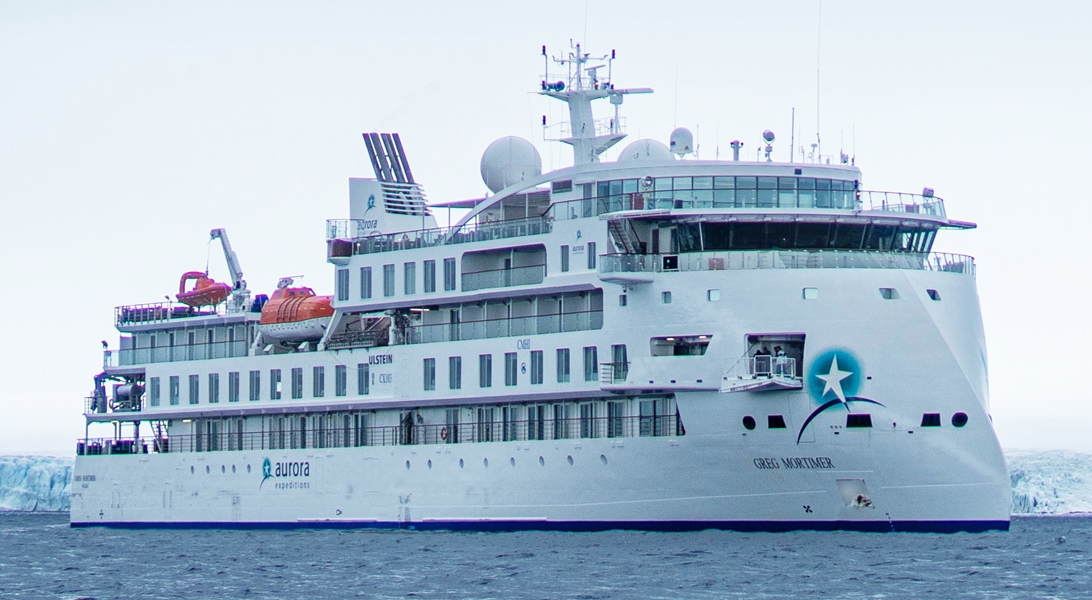






The images shown are for illustration purposes only and may not be an exact representation of what you find on the ship.
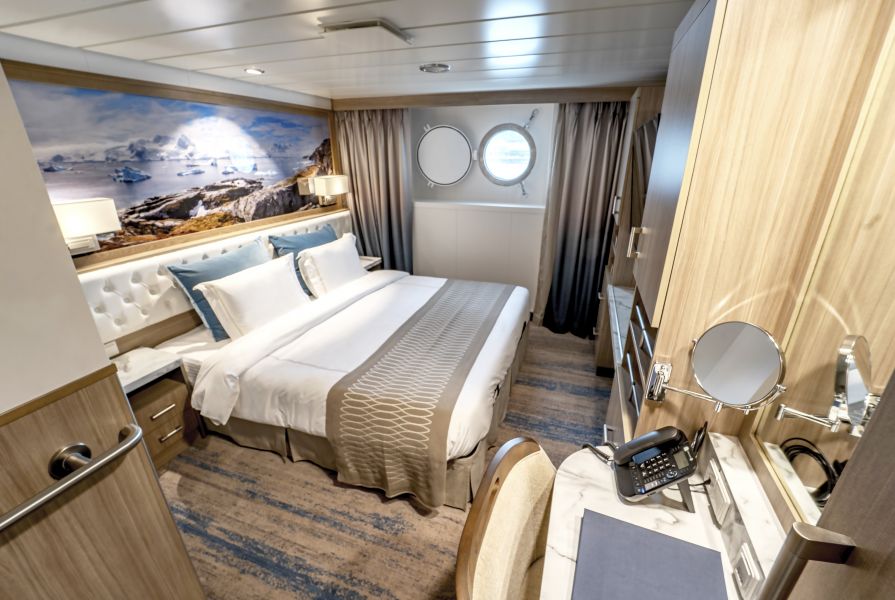
Greg Mortimer features 15 porthole rooms, all with private en-suites. Located on Deck 3, they're close to the mudroom and loading platforms, perfect for adventurers who are looking for a comfortable base that's close to the action.
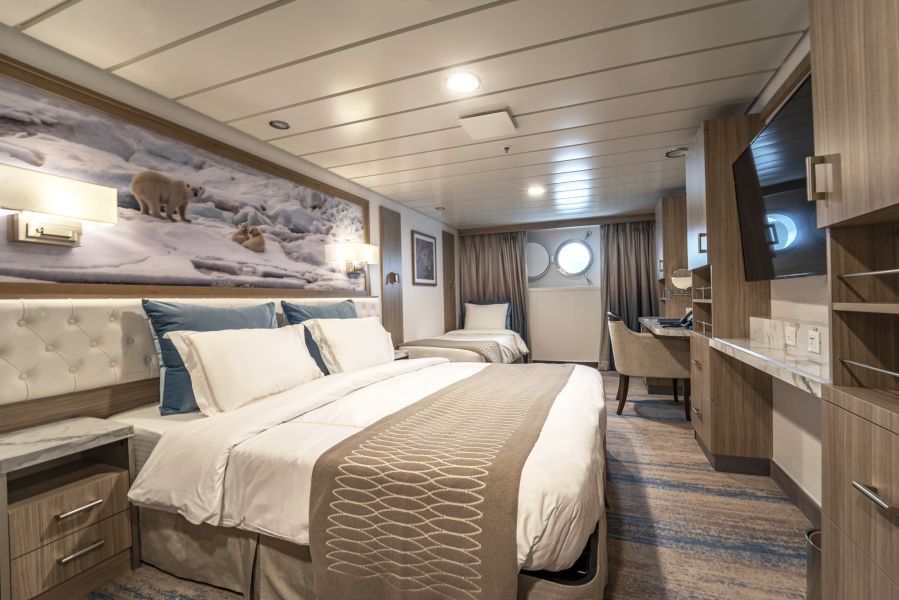
There are six Aurora Stateroom Triple cabins featuring portholes, all with private en-suites. Located on Deck 3, they're close to the mudroom and loading platforms. *Please note the Aurora Stateroom Triple cabins are only available on certain departures
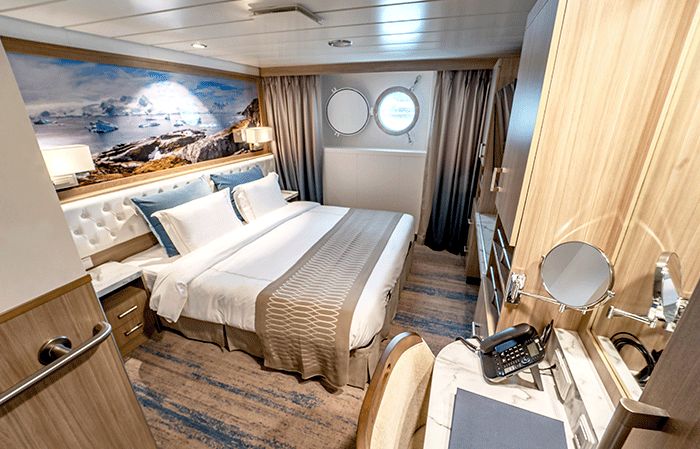
| Grade Code | From | To | |
| AS2G | Aurora Stateroom Twin | £10,889 | £10,889 |
The Greg Mortimer features eight Aurora Stateroom Twin cabins featuring portholes, all with private en-suites. Located on Deck 3, they're close to the mudroom and loading platforms, perfect for adventurers who are looking for a comfortable base that's close to the action.
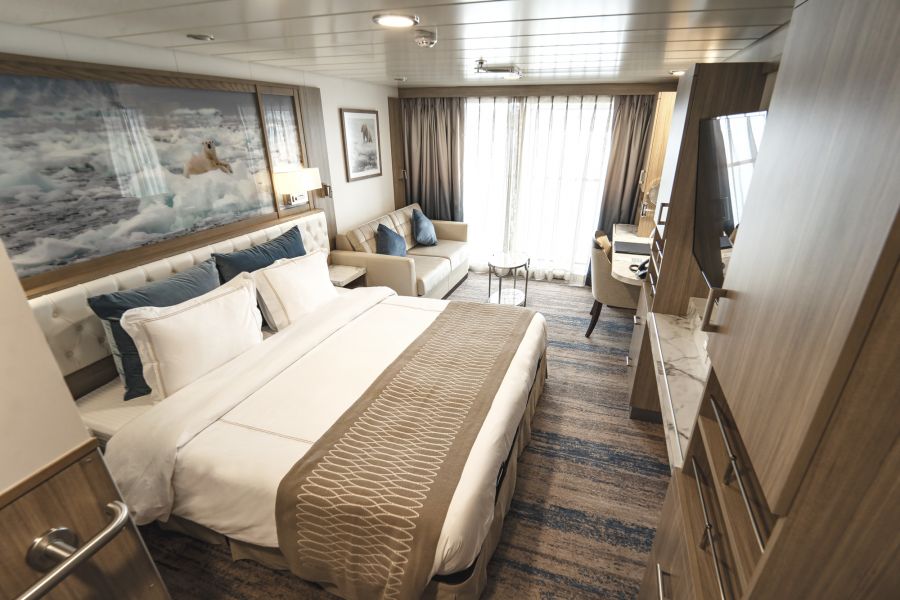
| Grade Code | From | To | |
| BSCG | Balcony Stateroom C (Forward / Aft) | £11,841 | £11,841 |
| BSBG | Balcony Stateroom B (Off Midship) | £12,496 | £12,496 |
| BSAG | Balcony Stateroom A (Midship) | £13,389 | £13,389 |
With 58 rooms available, the Greg Mortimer's Balcony Staterooms are the most abundant cabin category on board. All include en-suite bathrooms, floor to ceiling windows and balconies and a select number are also connecting rooms, perfect for families or groups.
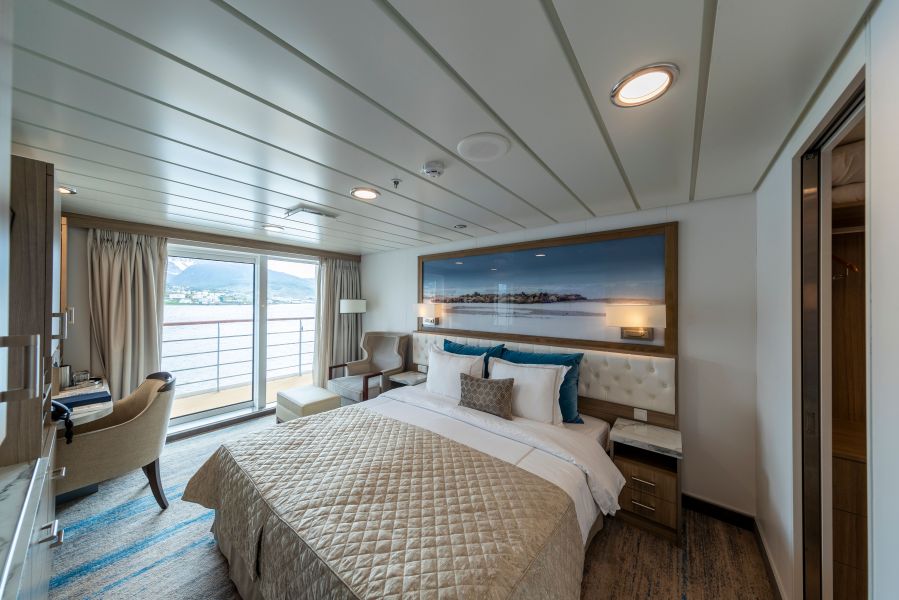
| Grade Code | From | To | |
| CSG | Captain's Suite | £21,781 | £21,781 |
The largest of all our rooms, the Greg Mortimer's singular Captain's Suite will take you to the polar regions in ultimate style and comfort. Complete with large lounge area, balcony, walk-in wardrobe and en-suite, you'll need to get in early to secure this suite.
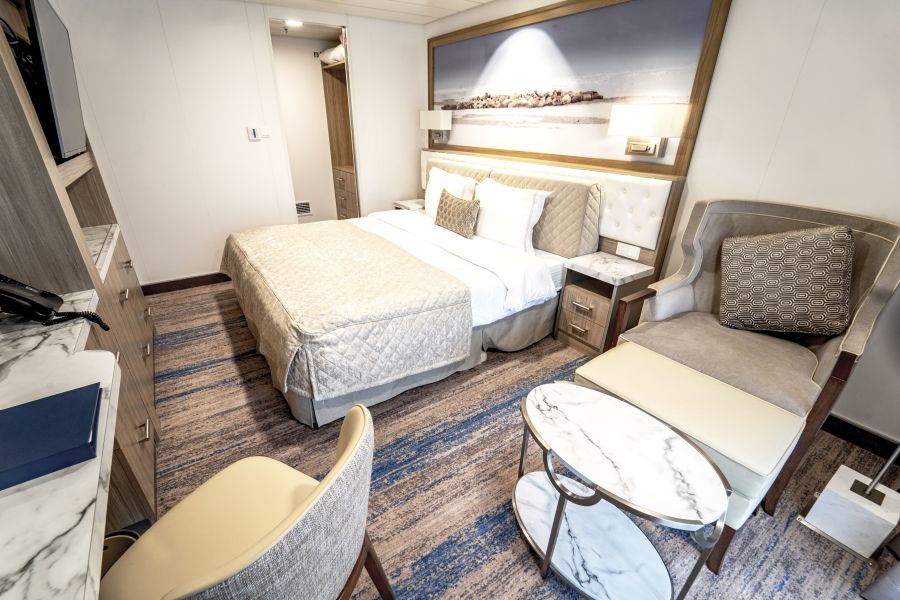
| Grade Code | From | To | |
| JSG | Junior Suite | £18,388 | £18,388 |
The Greg Mortimer's four Junior Suites take in some impressive∘ scenery from their vantage points on Deck 7. When you aren't enjoying a landing, you can relax in the suites' separate lounge area, or just watch the world float by from the private balcony.
The images shown are for illustration purposes only and may not be an exact representation of what you find on the ship.

Meals are served in a large restaurant with family style dining, perfect to swap stories with your new expedition family. Additionally, a private dining area will also be available on request. Enjoy the range of house wine, beers and soft drinks included with dinner after a long day in the wild, preparing yourself for another exciting day to follow.
On the last day of your trip, the team on the Greg Mortimer put on a special farewell four-course dinner and cocktails – a perfect way to reflect on your time on the ship and consolidate lifelong friendships with the people you've met on-board.
The images shown are for illustration purposes only and may not be an exact representation of what you find on the ship.
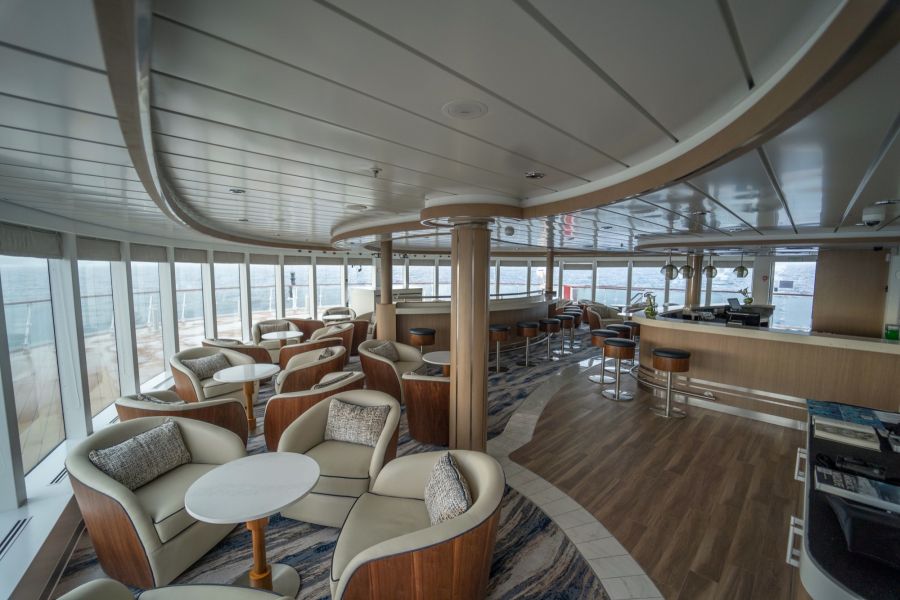
Let's face it – you don't want windowless rooms when travelling around some of the most beautiful locations around the world. This is why the Greg Mortimer is designed with plenty of dedicated observation spaces – ideal for keen bird spotters, wildlife watchers and those wanting to watch the scenery go past.
From the indoor 180-degree lounge and outdoor 360-degree open deck, both on deck 8, to the 270-degree open sundeck on level 7, there are plenty of observation points to share around the ship! If these are full, then you can take up a spot on one of the two hydraulic viewing platforms on deck 5.
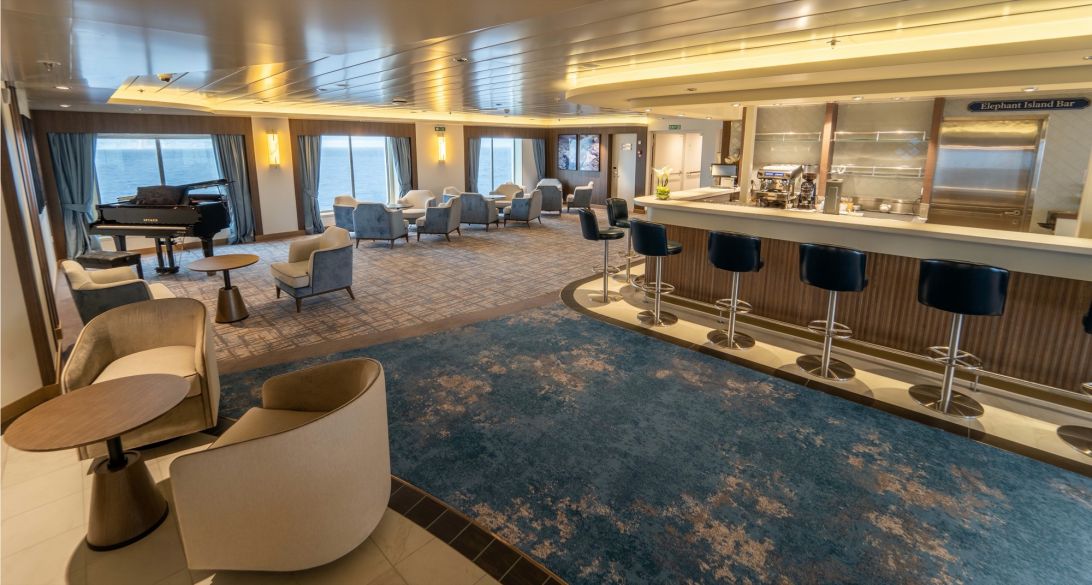
Communal meeting areas have always played a major role in fostering the warm camaraderie on board our ships. They are the heart of the expedition, where people meet to share tales from the day, swap photos, keep an eye out for wildlife and watch the sun go down.
The bars and lounges on board are refined yet inviting places to gather, with floor-to-ceiling windows offering stunning views, and of course friendly bartenders to shoot the breeze with.
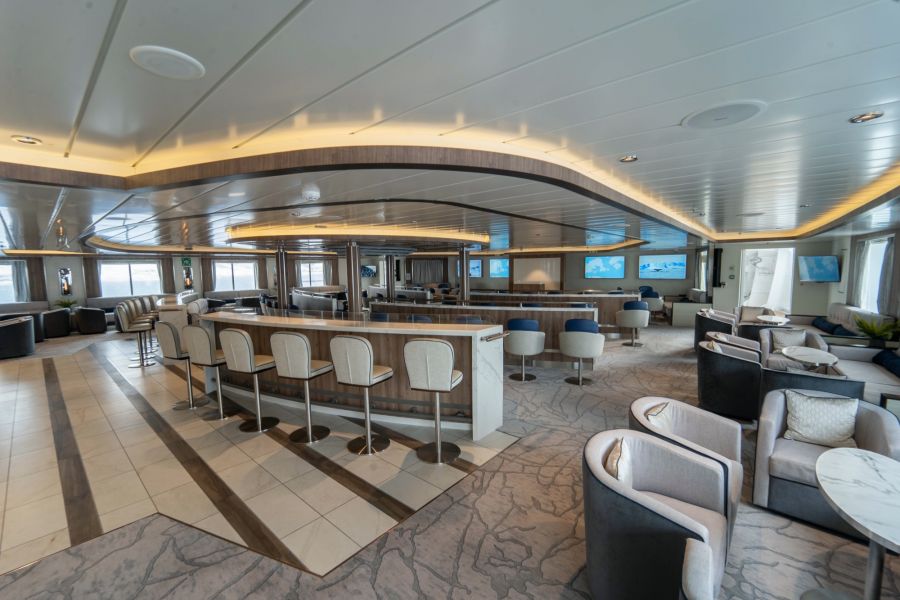
On all our expeditions, there are experts who lead presentations in the spacious lecture room so you can understand the region a little better. These often include topics as broad as history and culture to biology and climate change, these presentations aim to educate and entertain.
The images shown are for illustration purposes only and may not be an exact representation of what you find on the ship.
The images shown are for illustration purposes only and may not be an exact representation of what you find on the ship.
| 12 nights aboard the Greg Mortimer | |||
| Fully-serviced accommodation in your chosen stateroom | |||
| An informative and entertaining lecture program by our team of experts | |||
| Complimentary 3-in-1 polar jacket and the use of gumboots | |||
| Entry fees to historic or tourist sites | |||
| Daily shore excursions, guided walks, Zodiac cruises and some activities | |||
| Daily breakfast, lunch and dinner including house wines, beers and soft drinks and afternoon tea and snacks | |||
| Complimentary use of fitness centre | |||
| Comprehensive pre-departure information kit and destination resource guide | |||
| Captain’s Welcome and Farewell Cocktail Reception including four-course dinner, house cocktails, house beer and wine, non-alcoholic beverages | |||
| Complimentary access to onboard medical doctor or clinic, if required | |||
| An experienced team of destination specialists and activity leaders | |||
| Pre-dinner cocktail hour including cold canapes and bar snacks | |||
| Photographic voyage log (post-voyage) | |||
| Port Taxes and Fees | |||
 | ABTA and ATOL Protection* | ||
Date 21st Feb 2026 |
Nts 12 |
Oceanview  |
Balcony £11,841pp |
Suite £18,388pp |
Date 21st Feb 2026 |
Nts 12 |
Oceanview  |
Balcony £11,841pp |
Suite £18,388pp |

| Oceanview staterooms |  | ||
| AS2G | Aurora Stateroom Twin |  | |
| Balcony staterooms from | £11,841pp | ||
| BSCG | Balcony Stateroom C (Forward / Aft) | £11,841pp | |
| BSBG | Balcony Stateroom B (Off Midship) | £12,496pp | |
| BSAG | Balcony Stateroom A (Midship) |  | |
| SBSG | Superior Balcony Stateroom | £14,639pp | |
| Suite staterooms from | £18,388pp | ||
| JSG | Junior Suite | £18,388pp | |
| CSG | Captain's Suite | £21,781pp | |
| Oceanview | Balcony | Suite | |
| (All prices are £GBP per person) | |||
| Tue 16th Dec 202516 Dec 25 |
 |
15,025 |
 |
Fusion Cruises when selling travel arrangements is a trading name of The Midcounties Co-operative Ltd. Fusion Cruises is an Accredited Body Member of Midcounties Co-operative Travel Consortium. (ABTA:P6652, ATOL:6053).
Book with Confidence. We are a Member of ABTA which means you have the benefit of ABTA’s assistance and Code of Conduct.
Some of the flights and flight-inclusive holidays on this website are financially protected by the ATOL scheme but ATOL protection does not apply to all holiday and travel services offered on this website. This website will provide you with information on the protection that applies in the case of each holiday and travel service offered before you make your booking. If you do not receive an ATOL Certificate then the booking will not be ATOL protected. If you do receive an ATOL Certificate but all parts of your trip are not listed on it, those parts will not be ATOL protected. Please see our booking conditions for information, or for more information about financial protection and the ATOL Certificate go to: www.caa.co.uk
